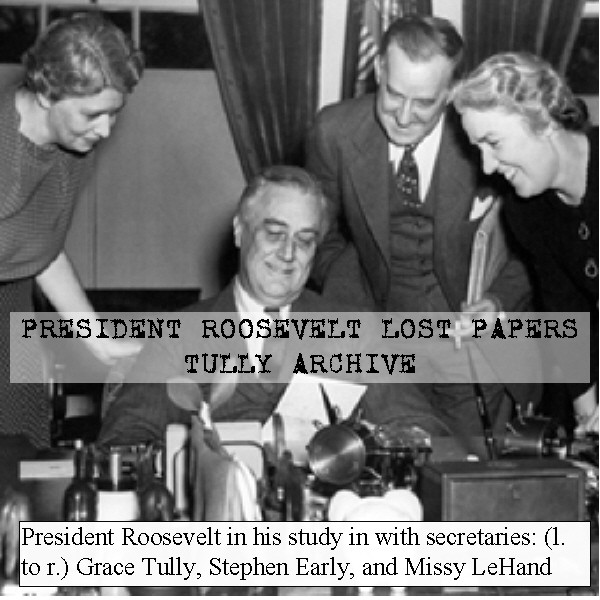
President Franklin D. Roosevelt “Lost Files” and FDR Secretary Papers
$19.50
Description
FDR and His Secretaries: A Timeline and Cast
Timeline of Main Events
- 1920: Marguerite “Missy” A. LeHand begins working at the Democratic National Committee headquarters.
- Post-1920: Franklin D. Roosevelt hires Missy LeHand as his personal secretary after his defeat as the vice-presidential nominee.
- 1921: Franklin D. Roosevelt contracts polio. Missy LeHand works for him during his recovery.
- 1928: Grace Tully is hired by the Democratic National Committee to assist Eleanor Roosevelt during the presidential campaign for Al Smith. Later in the year, Tully begins working on Franklin D. Roosevelt’s staff during his campaign for Governor of New York.
- 1929-1932: Grace Tully works in Albany during Franklin D. Roosevelt’s tenure as Governor of New York, performing dictation and typing duties that Missy LeHand disliked.
- 1932: Grace Tully works on FDR’s campaign and witnesses the drafting of his speech accepting the Democratic nomination for the presidency in Chicago (July 2).
- 1933: Franklin D. Roosevelt is inaugurated as President. Grace Tully and Missy LeHand move to the White House. Breckinridge Long presents FDR’s letter and a gift to Benito Mussolini in Italy (around June).
- May 16, 1933: Draft of FDR’s “Appeal to Nations of the World on Disarmament.”
- 1935: FDR lists “Must” legislation for the year, including Social Security and the Wagner Labor Bill (May 31). FDR sends a “chit” to Harry Hopkins about works programs to employ the unemployed and consume cotton (July 6). Eleanor Roosevelt writes to Missy LeHand from Campobello, mentioning Tully’s upcoming birthday (July 30). Draft of FDR’s “Message to Congress on the Use of National Resources” (January 24). Social Security Act and Wagner Act are signed into law.
- Ca. 1936: FDR writes a “chit” regarding the promotion of Col. George C. Marshall to Brigadier General. Draft of FDR’s “Message to Congress Vetoing the Soldiers’ Bonus for a Second Time” (January 24). Draft of the “Democratic National Platform” (June 25). Draft of FDR’s “Acceptance Speech on Renomination for the Presidency” in Philadelphia (June 27).
- April 14, 1938: Draft of FDR’s “Message to Congress on Stimulating Recovery” and his “Fireside Chat on Economic Conditions.” Draft of FDR’s “Radio Address on Third Anniversary of Social Security” (August 15).
- January 4, 1939: Draft of FDR’s “Annual Message to Congress.”
- October 3, 1939: Ambassador Joseph P. Kennedy writes a personal letter to Missy LeHand about the outbreak of World War II in Europe.
- January 20, 1941: Draft of FDR’s “Third Inaugural Address.”
- 1941: Missy LeHand suffers a debilitating stroke. Grace Tully becomes FDR’s primary personal secretary. Draft of FDR’s “Address at the White House Correspondents’ Dinner” (March 15).
- November 26, 1943: FDR writes a letter to Grace Tully from Cairo, Egypt, where he is meeting with Winston Churchill and Chiang Kai-Shek.
- June 6, 1944: Draft of FDR’s “D-Day Prayer.”
- April 5, 1945: Lucy Mercer Rutherfurd writes to Grace Tully to arrange a visit to FDR in Warm Springs with Madame Elizabeth Shoumatoff and Nicholas Robbins.
- April 12, 1945: Franklin D. Roosevelt dies in Warm Springs, Georgia, with Lucy Mercer Rutherfurd, Elizabeth Shoumatoff, and Nicholas Robbins present. Grace Tully is also present.
- Post-April 1945: Grace Tully becomes executive secretary of the Franklin D. Roosevelt Memorial Foundation. She is also appointed to a committee to steward FDR’s papers.
- Late 1940s: The committee stewarding FDR’s papers is disbanded after ownership is confirmed by the government.
- 1955-1965: Grace Tully works for the Senate Democratic Policy Committee, closely with Lyndon B. Johnson.
- 1980: Grace Tully mentions in a New York Times interview that she possesses handwritten notes from FDR, prompting the Roosevelt Library to seek their donation. She declines but indicates they will eventually receive them.
- June 15, 1984: Grace Tully dies. The “Tully Archive” passes to her sister, Paula Larrabee.
- March 11, 1985: The Roosevelt Library makes a final unsuccessful attempt to contact Paula Larrabee regarding the archive.
- Circa 2000: The Tully Archive is put up for sale by Guernsey Auction house in New York and is believed to be acquired by Glenn Horowitz Bookseller. Roosevelt Library Director Cynthia Koch sees portions of the collection.
- 2002: Lord Conrad Black purchases the Tully Archive for $8 million.
- August 2004: The National Archives is notified that the collection is up for auction at Christie’s.
- 2005: The National Archives halts the auction and asserts a claim over a portion of the Tully Archive, initiating negotiations with Sun Times Media. The entire collection is moved to the FDR Library for safekeeping.
- February 2010: President Barack Obama signs SB 692 into law, facilitating the donation of the Tully Archive to the National Archives and Records Administration.
- Post-February 2010: The Tully Archive is donated to the National Archives and becomes available to the public in 2011.
Cast of Characters
- Franklin D. Roosevelt (FDR): 32nd President of the United States (1933-1945). Previously served as Governor of New York. The central figure whose papers and secretaries are the subject of the source.
- Grace Tully: Franklin D. Roosevelt’s last personal secretary. Started working for him during his 1928 gubernatorial campaign and remained until his death. Managed dictation, typing, mail, and speech files. Author of “FDR: My Boss.”
- Marguerite “Missy” A. LeHand: Franklin D. Roosevelt’s principal personal secretary prior to her stroke in 1941. Worked for FDR from the 1920s. Managed his schedule, read newspapers with him, and held power of attorney for his finances.
- Eleanor Roosevelt: Wife of Franklin D. Roosevelt and First Lady of the United States. The source reveals Grace Tully’s assistance to her and mentions her correspondence with both Tully and LeHand.
- Paula Tully/Paula Larrabee: Grace Tully’s sister who also worked in the White House. Inherited the Tully Archive after Grace’s death.
- George C. Marshall: Military officer who was encouraged for promotion to Brigadier General by FDR in a “chit” in 1936. Later became Chief of Staff of the Army and a key advisor during WWII.
- John J. Pershing: Highly respected General and hero of World War I who encouraged the promotion of George C. Marshall.
- Harry Hopkins: Administrator of the Works Progress Administration (WPA). Received a “chit” from FDR in 1935 regarding employing the unemployed in clothing production.
- Winston Churchill: Prime Minister of the United Kingdom during World War II. Met with FDR in Cairo in 1943.
- Chiang Kai-Shek: Leader of the Republic of China. Met with FDR and Churchill in Cairo in 1943.
- Joseph Stalin: Leader of the Soviet Union. Met with FDR and Churchill at the Teheran Conference after the Cairo meeting.
- Joseph P. Kennedy: U.S. Ambassador to the United Kingdom at the outbreak of World War II. Corresponded with Missy LeHand, sharing his views on the war.
- William C. Bullitt: U.S. Ambassador to France at the outbreak of World War II. Corresponded with Missy LeHand.
- Carmel Offie: Assistant to Ambassador William C. Bullitt in Paris. Corresponded with Missy LeHand.
- Sara Delano Roosevelt: Franklin D. Roosevelt’s mother. Corresponded with Missy LeHand.
- Benito Mussolini: Fascist dictator of Italy. Exchanged a letter with FDR in 1933 expressing gratitude and a desire to meet.
- Breckinridge Long: United States Ambassador to Italy who delivered FDR’s letter to Mussolini.
- Lucy Mercer Rutherfurd: Woman with whom FDR had an affair in the past. Maintained contact with FDR later in his life, with Grace Tully’s assistance. Was present at Warm Springs when FDR died.
- Madame Elizabeth Shoumatoff: Famed portrait painter who was painting FDR in Warm Springs when he died. Her portrait remained “The Unfinished Portrait.”
- Nicholas Robbins: Photographer who accompanied Madame Elizabeth Shoumatoff to Warm Springs.
- Lyndon B. Johnson: Served as Senate Majority Leader and later as President of the United States. Grace Tully worked for him on the Senate Democratic Policy Committee after FDR’s death.
- Lady Bird Johnson: Wife of Lyndon B. Johnson. Corresponded with Grace Tully after the Roosevelt years.
- Vincent Astor, Admiral Richard E. Byrd, William J. Donovan, William Douglas, Dwight D. Eisenhower, Felix Frankfurter, Lord Halifax, J. Edgar Hoover, Cordell Hull, Harold L. Ickes, Joseph P. Kennedy (Ambassador to UK), Henry Jr. Morgenthau, Francis J. Spellman, Adlai E. Stevenson, Harry S. Truman: Individuals who corresponded with Grace Tully, indicating her broad network.
- Al Smith: Democratic presidential nominee in 1928, during whose campaign Grace Tully first worked for Eleanor Roosevelt.
- Bishop Patrick Hayes (later Cardinal Hayes): Grace Tully worked as his secretary for ten years before joining the Democratic National Committee.
- William R. Emerson: Director of the Roosevelt Library in 1980 who sought the donation of Grace Tully’s FDR materials.
- Cynthia Koch: Roosevelt Library Director in 2000 who recognized the significance of portions of the Tully Archive.
- Lord Conrad Black: CEO of Hollinger International Corporation who purchased the Tully Archive in 2002 and is the author of a biography of FDR.
- Charles Schumer: U.S. Senator from New York who sponsored SB 692 in the Senate.
- Louise Slaughter: U.S. Representative from New York who sponsored SB 692 in the House.
- Barack Obama: President of the United States who signed SB 692 into law in 2010
President Franklin D. Roosevelt “Lost Files” and FDR Secretary Papers
7,455 pages of President Franklin D. Roosevelt papers unavailable to the public until 2011 and the papers of FDR secretaries Grace Tully and Marguerite A. LeHand
This compilation contains three distinct collections, which are often referred to as the Tully Archive. Grace Tully was President Roosevelt’s last personal secretary. They are called the Tully Archive because before being obtained by the National Archives and Records Administration, they were all in the possession of Grace Tully.
Grace Tully was the last personal secretary of President Franklin D. Roosevelt. She first started working for Roosevelt during the 1928 New York State Governor campaign, and remained on his staff until his death in 1945. Her primary duties included dictation, typing of speech drafts, the President’s mail, and oversight of the President’s speech files.
The three collections in this compilation are:
Franklin D. Roosevelt Papers
This collection can truly be described as a “first draft of history.” As FDR’s personal secretaries, both Missy LeHand and Grace Tully took dictation, drafted correspondence, and worked on the President’s speech drafts. As a result, LeHand and Tully handled drafts of correspondence, handwritten notes or chits from FDR that would have been typed into memorandum form, and first and intermediate drafts of speeches and messages. This collection contains all of this variety of material and is primarily composed of documents that normally would have been filed in FDR’s own papers in the White House that went to the National Archives after his death. For reasons unknown, this material remained in the custody of his secretaries and became part of the Tully Archive instead of being filed within FDR’s own papers.
Grace Tully Papers
This collection includes an extensive series of personal correspondence between Grace Tully, Franklin and Eleanor Roosevelt, other members of the Roosevelt Administration and White House staff, friends and family. A recurring name throughout the correspondence is Paula Tully/Paula Larrabee. Paula was Grace’s sister who also worked in the White House. Of particular interest in the correspondence files are letters from Eleanor Roosevelt revealing the extent to which Grace assisted Mrs. Roosevelt in her day-to-day activities. There also is correspondence exchanged between Tully and Lyndon B. and Lady Bird Johnson that casts light on Grace’s life after the Roosevelt years. The collection also contains a series of writings by Grace Tully, including draft notes and chapters for her book “FDR: My Boss” as well as unpublished reminiscences of FDR. Finally, there is an extensive series of memorabilia, including copies of FDR speech texts inscribed by the President to Grace, copies of White House press releases, a set of official Logs of the President’s Trips, inauguration memorabilia, and colorful menus from railroad trips Grace took with the President.
The collection includes correspondence with Vincent Astor, Admiral Richard E. Byrd, William J. Donovan, William Douglas, Dwight D. Eisenhower, Felix Frankfurter, Lord Halifax, J. Edgar Hoover, Cordell Hull, Harold L. Ickes, Joseph P. Kennedy, Henry, Jr. Morgenthau, Francis J. Spellman, Adlai E. Stevenson, and Harry S. Truman.
Marguerite “Missy” A. LeHand Papers
This collection is composed primarily of personal correspondence files. Of particular importance are personal letters Missy received from diplomatic figures abroad at the outbreak of and in the early years of the war, including Ambassador Joseph P. Kennedy in London, Ambassador. William C. Bullitt in Paris, and Carmel Offie, Bullitt’s assistant in Paris. Also interesting are the letters from FDR’s mother Sara Delano Roosevelt. The collection also includes Missy’s 1935 Testamentary Instructions as well as a draft article about her experiences working in the White House with FDR.
Highlights from the three collections include:
FDR “Chit” regarding Promotion of George C. Marshall to Brigadier General, ca. 1936. This document is an example of what the White House staff referred to as a “chit”—a short hand-written note that was the basis for a typewritten memorandum or letter. In this chit from early 1936, FDR is requesting that the Secretary of War proceed with the next military officer promotion list so as to promote Col. George C. Marshall to Brigadier General. Marshall’s promotion was encouraged by the hero of World War I, the highly respected Gen. John J. Pershing. Three years later, the President named Marshall to be the Chief of Staff of the Army, and he was one of FDR’s most trusted and indispensable military advisers during World War II.
Letter from Joseph P. Kennedy to Marguerite “Missy” LeHand, October 3, 1939. A month after the outbreak of World War II in Europe, U.S. Ambassador to the United Kingdom Joseph P. Kennedy wrote as personal letter to Missy LeHand, FDR’s primary personal secretary and close associate and friend of Grace Tully. From this letter, it is obvious that there is a personal connection between Kennedy, LeHand and Tully. In the letter, after taking care of some personal business, Ambassador Kennedy describes his views on the war, the social scene in London following the outbreak, and the loneliness of serving abroad without his family.
Letter from Benito Mussolini to FDR, ca. June 1933. Shortly after his inauguration in March 1933, President Roosevelt appointed Breckinridge Long to be the United States Ambassador to Italy. Upon presenting his credentials to Mussolini, Ambassador Long also gave Il Duce a letter from FDR and the gift of an inscribed copy of President Roosevelt’s First Inaugural Address. In this unique handwritten letter, Mussolini expresses his deep gratitude and admiration to the President. Il Duce also expresses his hope that he and FDR might meet one day to “discuss the outstanding world problems in which the United States and Italy are mutually interested.” The letter was delivered through the State Department to the White House. The National Archives does not know how this letter ended up in Grace Tully’s private possession.
Letter from Lucy Mercer Rutherfurd to Grace Tully, April 5, 1945. In this handwritten letter written to Grace Tully one week before FDR’s death in Warm Springs, Georgia, Lucy Mercer Rutherfurd makes arrangements for herself, famed portrait painter Madame Elizabeth Shoumatoff, and Shoumatoff’s photographer Nicholas Robbins to come to President Roosevelt’s retreat at Warm Springs. As is well known, Lucy Mercer and FDR had a brief affair which, when discovered by Eleanor Roosevelt in 1918, forever changed the nature of their marriage. FDR continued to maintain some limited contact with Rutherfurd throughout his life, increasing to more frequent social visits and car rides together during the last year and a half of FDR’s life as he grew weary and isolated with his wartime duties. As this letter suggests, Grace Tully played a major role in facilitating these private meetings that were kept secret from Eleanor Roosevelt until after FDR’s death. Rutherfurd, Shoumatoff and Robbins were at Warm Springs with FDR when he was stricken with the massive cerebral hemorrhage from which he would die a few hours later. The portrait being painted by Shoumatoff would forever remain “The Unfinished Portrait.”
FDR Chit Listing “Must” Legislation for 1935, May 31, 1935. This handwritten list by FDR indicates his legislative priorities for the year 1935, including Social Security and the Wagner Labor Bill. Both of these bills were signed into law in 1935 are among the most lasting products of the New Deal.
FDR Chit to Harry Hopkins about Works Programs, July 6, 1935. This chit in FDR’s hand is addressed to Harry Hopkins, administrator of the Works Progress Administration. It shows the interconnectedness in FDR’s mind of all aspects of the economy. FDR instructs Hopkins to put 280,000 unemployed people to work making overalls and other clothing because this not only would give them gainful employment, but also consume 750,000 bales of cotton that would increase cotton prices.
Letter from FDR to Grace Tully, November 26, 1943. This letter in FDR’s handwriting was sent to Grace Tully from Cairo, Egypt where the President was meeting with Winston Churchill and Chiang Kai-Shek before proceeding on to the Teheran Conference with Churchill and Stalin. The letter would have accompanied the pouch of the President’s paperwork, such as letter, bills signed into law, appointments, and nominations, sent back to the White House from Cairo via military transport. Its kind and joking nature reveals the affectionate place Tully held in Roosevelt’s official family.
Letter from Eleanor Roosevelt to Grace Tully, ca. 1930. This letter from Eleanor Roosevelt was written to Grace Tully during the years that Franklin Roosevelt served as Governor of the State of New York
(1929-1932). Although Tully primarily served on Roosevelt’s secretarial staff, she actually got her start with the Roosevelts working with Mrs. Roosevelt during the 1928 campaign. It reveals not only the variety of tasked, both personal and official, that Tully performed for the Roosevelts, but also the busy schedule of activities kept by Mrs. Roosevelt.
Letter from Eleanor Roosevelt to Missy LeHand, July 30, 1935. Like Grace Tully, Missy LeHand was also an integral part of the Roosevelts’ official family. This letter written by Mrs. Roosevelt from Campobello, New Brunswick shows not only Mrs. Roosevelt keeping up with her official activities, but also remembering more personal issues, such as suggesting a cake for Tully’s upcoming birthday.
Drafts of important speeches including, Speech Accepting the Democratic Nomination for the Presidency, Chicago, Illinois, July 2, 1932; Appeal to Nations of the World on Disarmament, May 16, 1933; Message to Congress on the Use of National Resources, January 24, 1935; Message to Congress Vetoing the Soldiers’ Bonus for a Second Time, January 24, 1936; Democratic National Platform, June 25, 1936; Acceptance Speech on Renomination for the Presidency, Philadelphia, Pennsylvania, June 27, 1936; Message to Congress on Stimulating Recovery, April 14, 1938; Fireside Chat on Economic Conditions, April 14, 1938; Radio Address on Third Anniversary of Social Security, August 15, 1938; Annual Message to Congress, January 4, 1939; Third Inaugural Address, January 20, 1941
Address at the White House Correspondents’ Dinner, March 15, 1941; D-Day Prayer, June 6, 1944.
History of the Collection
In 1980, Grace Tully gave an interview to the New York Times in which she mentioned that she had several dozen handwritten notes written by Franklin Roosevelt. The director of the Roosevelt Library at the time, William R. Emerson immediately wrote to Tully asking her to consider donating these materials to the Library. She declined, but stated that the Library would “undoubtedly get them” after her death.
Grace Tully died on June 15, 1984. She never married and had no children. The Archive passed into the hands of her surviving sister Paula Larrabee, who also worked in the Roosevelt White House. Emerson reached out to her without success.
On March 11, 1985 Emerson wrote again to Mrs. Larrabee and again expressed interest in obtaining Grace’s collection of Roosevelt materials. No further contact between the National Archives and Grace’s family took place after this. The Tully collection then disappeared. At some point it passed into the hands of two people (perhaps relatives, but this is unclear) who acted as caretakers for Mrs. Larrabee until her death. It is believed that the Archive passed from these individuals to a small auction house in Atlanta.
In 2000, the Archive was placed for sale through the Guernsey Auction house in New York. It is believed that Glenn Horowitz Bookseller, New York, New York, acquired the Archive for approximately $3.5 million and began preparing it for resale. It was during an event at the Horowitz showroom in 2000 that Roosevelt Library Director Cynthia Koch saw portions of the collection on display and suspected the true extent of the materials.
In 2002, the Tully Archive was purchased by Lord Conrad Black, CEO of Hollinger International Corporation, for $8 million. Lord Black is the author of “Franklin Delano Roosevelt: Champion of Freedom.”
In August 2004, the National Archives was notified that Hollinger and its successor Sun Times Media Group had placed the collection up for auction at Christie’s in New York, where it was to be broken up and sold in lots. Christie’s allowed a team from the National Archives to survey the collection. The collection amounted to over 5,000 documents and memorabilia items, including personal letters, speech drafts, and notes or “chits” written by FDR giving instructions or directions to his staff and administration officials.
It was determined that portions of the collection were clearly presidential materials that should have passed to the FDR Presidential Library in accordance with President Roosevelt’s directions prior to his death. In 2005, general counsel for the National Archives halted the auction and asserted a claim over a portion of the Tully Archive.
Thus began five years of negotiation with Sun Times Media. By agreement of the parties, in July 2005, the Library boxed and sealed the entire collection and removed it from Christie’s to the FDR Library at Hyde Park for safekeeping pending the outcome of the negotiations or any litigation. Over the course of the ensuing years, negotiations slowly pushed through to a successful resolution despite many ups and downs, including the bankruptcy of Sun Times Media.
An important part of that resolution was literally an Act of Congress. In February 2010 of President Barack Obama signed into law SB 692, sponsored in the Senate by Charles Schumer (D-NY) and in the House by Rep. Louise Slaughter (D-NY), facilitating the donation of the Tully Archive in its entirety. The law provided for the waiver of the government’s claims to the papers provided that the owner made a gift of the entire collection to the National Archives and Records Administration.
About Grace Tully
Grace Tully was born in Bayonne, New Jersey on August 9, 1900. Her father died when she was young, and she her two sisters and brother were raised by their mother. She attended parochial and convent schools before enrolling in secretarial school. After finishing school she worked ten years for Bishop Patrick Hayes, who became Cardinal Hayes.
In 1928, she was hired by the Democratic National Committee and was assigned to assist Eleanor Roosevelt who was organizing support for presidential nominee Al Smith. When FDR was nominated for Governor later that year, Tully went to work on Roosevelt’s staff.
Tully performed the dictation and typing duties that FDR’s principal personal secretary Missy LeHand disliked. She served with FDR in Albany during his four years as Governor of New York. She later moved to Washington in 1933 when FDR was elected President. Roles of Tully and LeHand were by this time well defined and accepted. Grace performed dictation and typing, managed the President’s mail, and served as primary files manager for the White House.
After Missy LeHand suffered a stroke in 1941, Grace became FDR’s primary personal secretary. Tully was in Warm Springs with FDR when he died on April 12, 1945. She thereafter became executive secretary of the Franklin D. Roosevelt Memorial Foundation. Prior to his death, FDR appointed Grace to a three person committee to serve as a steward of FDR’s papers in preparation for their opening to researchers.
The papers committee was disbanded in the late 1940s after ownership of the FDR papers was confirmed in the United States government following the administration of Roosevelt’s estate. The establishment of the committee was deemed a non-testamentary request by the President not binding on the Archivist of the United States.
In 1955, Tully joined the staff of the Senate Democratic Policy Committee, working closely with then-Senate Majority leader Lyndon B. Johnson. She remained a Johnson aide there until 1965.
Grace Tully died on June 15, 1984 at George Washington University Hospital in Washington DC.
About Marguerite A. “Missy” LeHand
Marguerite A. LeHand, known as Missy, was born in Potsdam, New York on September 13, 1898, and grew up in Somerville, Massachusetts. LeHand held several clerical and secretarial jobs before going to work for the Democratic National Committee headquarters during the 1920 campaign. After the defeat of the 1920 Democratic ticket, including his own as the vice presidential nominee, Franklin D. Roosevelt, hired Missy as his personal secretary.
LeHand was working for FDR at the time he was stricken with polio in 1921. After FDR purchased property in Warm Springs, Georgia, Missy traveled with FDR and served as both personal secretary and hostess because Eleanor Roosevelt disliked Warm Springs. After FDR was elected Governor of New York, Missy continued to serve as sometime hostess in Albany in Mrs. Roosevelt’s absence.
Upon FDR’s election to the presidency, Missy accompanied the Roosevelts to Washington and moved into the White House.
Missy was principal personal secretary (“PS”) to the President, and she would meet with FDR in the morning as he took breakfast in bed, read the newspapers with him, and prepare for the day’s schedule. In addition to her official duties, Missy held power of attorney for FDR and managed his bank accounts, including paying his bills by check. Missy was considered a valued member of the inner circle, and her opinion on matters of state and of politics was sought and considered. She was “one of the boys” and would gather with the rest of FDR’s close advisers and listen to election returns, participate in regular card games, and attend FDR’s daily afternoon cocktail hours.
LeHand suffered a debilitating stroke in 1941 after working 21 years for FDR. She was hospitalized for several months, then continued her convalescence in Warm Springs and then in Massachusetts. Missy LeHand died on July 31, 1944. According to the terms of her 1935 Testamentary Instructions, Grace Tully oversaw the administration of her estate and was instructed to dispose of Missy’s papers, which is how it is believed that the LeHand Papers became part of the Tully Archive.
Source: National Archives and Records Administration
Related products
-
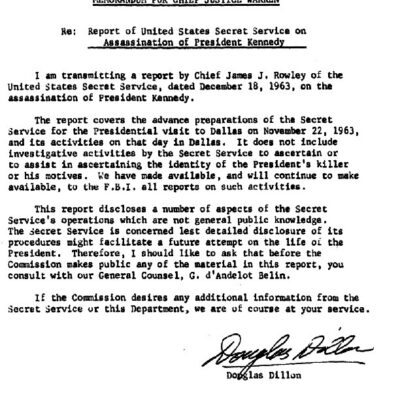

John F. Kennedy Assassination Secret Service Reports
$19.50 Add to Cart -
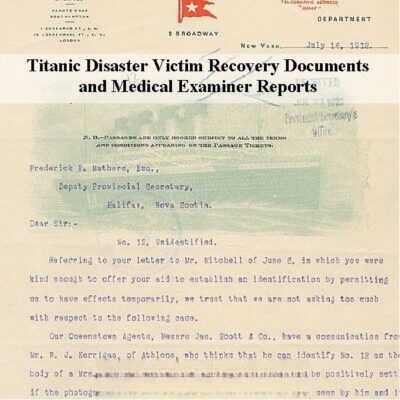
Titanic Disaster Victim Recovery and Medical Examiner Records
$19.50 Add to Cart -
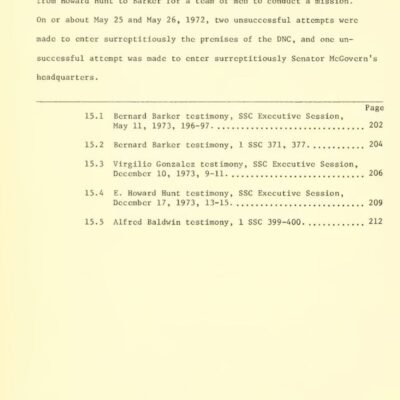
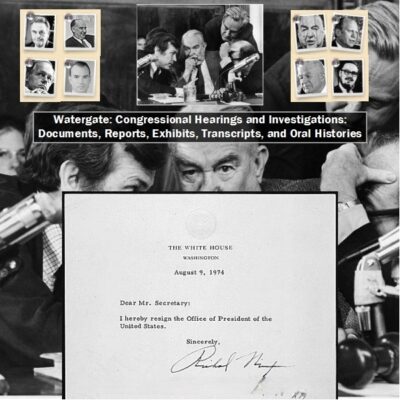
Watergate: Congressional hearings, reports, exhibits, and transcripts
$19.50 Add to Cart -
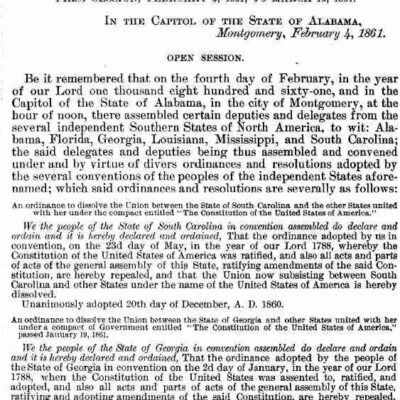
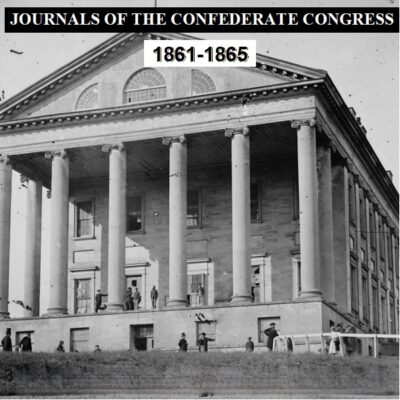
Journal of the Congress of the Confederate States of America 1861-1865
$19.50 Add to Cart